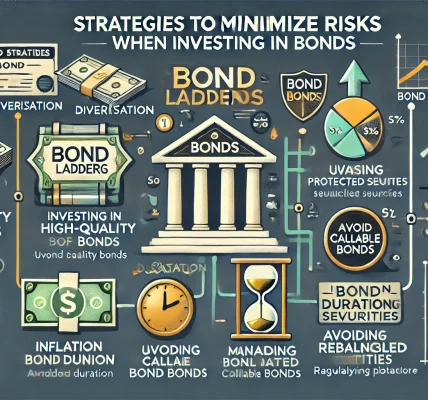Investing in bonds is often considered a safer and more stable option compared to equities. However, even the most conservative investments can go awry if common mistakes are not avoided. Misunderstanding bond dynamics, neglecting due diligence, or failing to diversify can lead to significant financial losses. This guide will highlight the most common bond investment mistakes and provide actionable strategies to avoid them.
1. Failing to Understand Bond Basics
Mistake:
Many investors jump into bond investing without understanding key concepts like bond prices, yields, and interest rate risks. Misinterpreting these basics can lead to poor decision-making.
How to Avoid:
- Learn key bond terminology:
- Coupon Rate: The fixed interest payment made annually or semi-annually.
- Yield to Maturity (YTM): The total return if the bond is held until it matures.
- Par Value: The face value repaid at maturity.
- Duration: A measure of a bond’s sensitivity to interest rate changes.
- Use educational resources like financial websites, courses, and bond investment guides.
2. Ignoring Interest Rate Risks
Mistake:
Assuming bond investments are risk-free is a critical error. Bond prices move inversely to interest rates, and rising rates can erode the market value of your bond holdings.
How to Avoid:
- Diversify bond investments across different maturities using a bond ladder strategy.
- Invest in floating-rate bonds or short-duration bonds to mitigate interest rate risks.
- Monitor central bank policies to stay informed on future interest rate changes.
3. Overlooking Credit Risk
Mistake:
Investors often chase high-yield bonds without assessing the creditworthiness of the issuer. Bonds from companies with poor credit ratings carry a higher risk of default.
How to Avoid:
- Check credit ratings from agencies like Moody’s, S&P, or Fitch:
- Investment Grade: Safer bonds with lower yields (AAA to BBB-).
- Junk Bonds: Higher risk, higher yields (BB+ and below).
- Diversify across different sectors and credit qualities.
- Focus on government or highly-rated corporate bonds for lower credit risk.
4. Neglecting Tax Implications
Mistake:
Ignoring the tax treatment of bond income can result in unexpected tax liabilities. For instance, interest from corporate bonds is taxed as ordinary income.
How to Avoid:
- Invest in tax-exempt municipal bonds if you are in a high tax bracket.
- Use tax-advantaged accounts (IRAs, 401(k)s) to hold taxable bonds.
- Understand the implications of capital gains if you sell bonds before maturity.
5. Focusing Solely on Yield
Mistake:
High-yield bonds are tempting, but focusing only on the yield can expose you to greater credit and interest rate risks.
How to Avoid:
- Analyze the risk-return tradeoff before investing in high-yield bonds.
- Maintain a balanced portfolio with a mix of investment-grade and high-yield bonds.
- Evaluate total return, including capital appreciation and yield, rather than yield alone.
6. Poor Diversification
Mistake:
Concentrating all your investments in one type of bond or issuer increases vulnerability to market shocks.
How to Avoid:
- Diversify across different categories:
- Government Bonds (e.g., U.S. Treasury Bonds)
- Corporate Bonds (Investment-grade and high-yield)
- Municipal Bonds (Tax-free income)
- International Bonds (Geographic diversification)
- Implement a bond ladder with staggered maturities.
7. Misjudging Liquidity Needs
Mistake:
Bonds are generally less liquid than stocks, meaning you might struggle to sell them quickly without a loss if you need cash.
How to Avoid:
- Keep an emergency fund separate from your bond investments.
- Prefer short-term bonds if you anticipate needing cash in the near future.
- Understand the bond’s liquidity profile before purchasing.
8. Timing the Market
Mistake:
Attempting to predict interest rate movements and time bond purchases or sales is a risky strategy.
How to Avoid:
- Adopt a buy-and-hold strategy to minimize the impact of market fluctuations.
- Use dollar-cost averaging to spread purchases over time.
- Focus on your long-term goals rather than short-term rate predictions.
9. Ignoring Inflation Impact
Mistake:
Fixed-income payments from traditional bonds lose purchasing power over time due to inflation.
How to Avoid:
- Invest in Treasury Inflation-Protected Securities (TIPS) for inflation-adjusted returns.
- Diversify into real assets like commodities or real estate.
10. Not Reviewing the Portfolio Regularly
Mistake:
Failing to review and adjust your bond portfolio can lead to unintended exposure or missed opportunities.
How to Avoid:
- Conduct regular portfolio reviews (at least annually).
- Rebalance your holdings to align with your risk tolerance and financial goals.
- Stay informed on market conditions and adjust your strategy accordingly.
Conclusion
Bond investments can provide stability and income, but avoiding common mistakes is essential for long-term success. By understanding key concepts, managing risks, and maintaining a diversified portfolio, you can maximize returns while minimizing pitfalls. Always perform due diligence, stay informed, and consult with financial professionals to ensure your bond strategy aligns with your broader financial objectives.




